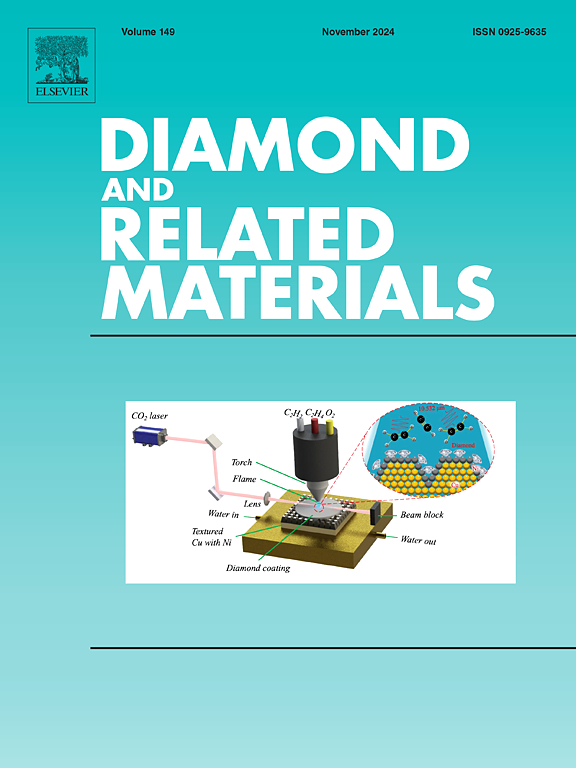Graphene quantum dots from pyrolytic condensation of aspartic acid and glycerol for ratiometric fluorosensing of lactic acid in cancer cells
IF 5.1
3区 材料科学
Q2 MATERIALS SCIENCE, COATINGS & FILMS
引用次数: 0
Abstract
In this study, strongly luminescent Graphene Quantum Dots (GQDs) of high quantum yield (QY ≈ 46 %) were synthesized by pyrolysis of aspartic acid in glycerol. Here we report the use of GQDs as a fluorescence ratiometric probe towards lactic acid (LA) in both serum and MCF-7 cell lysate medium. A remarkably low limit of detection (LOD) was found in serum medium (0.294 μM) and in MCF-7 cell extract (6.917 μM). Isothermal titration calorimetric studies yielded highly negative (−80.0 kcal mol−1) ΔH value in serum medium which suggested exothermic interactions between GQDs and lactic acid. The sensing capacity of the GQDs was further validated in presence of various interfering agents such as ascorbic acid, citric acid, nitrate, phosphate, glucose, cholesterol and uric acid in serum medium. Monitoring the amounts of LA in cancer cells is crucial as LA plays a significant role in the proliferation of cells. We therefore evaluated the performance of our ratiometric probe in measuring the intracellular LA concentration in MCF-7 cell lysate. The calibration curve of LA in MCF-7 cell lysate generated alongside in the concentration range 4.180–42.37 μM helped in accurately identifying the concentration of LA in cancer cells.

由天冬氨酸和甘油热解缩合而成的石墨烯量子点用于癌细胞中乳酸的比例荧光感应
本研究利用天冬氨酸在甘油中热解制备了高量子产率(QY≈46%)的强发光石墨烯量子点(GQDs)。在这里,我们报告了使用GQDs作为血清和MCF-7细胞裂解液培养基中乳酸(LA)的荧光比例探针。血清培养基(0.294 μM)和MCF-7细胞提取液(6.917 μM)的检出限极低。等温滴定量热研究在血清培养基中得出高度负(- 80.0 kcal mol - 1) ΔH值,表明GQDs与乳酸之间存在放热相互作用。进一步验证了GQDs在血清培养基中抗坏血酸、柠檬酸、硝酸盐、磷酸盐、葡萄糖、胆固醇和尿酸等多种干扰物存在下的传感能力。由于LA在细胞增殖中起着重要作用,因此监测癌细胞中LA的含量至关重要。因此,我们评估了比率探针在测量MCF-7细胞裂解液中细胞内LA浓度方面的性能。MCF-7细胞裂解液中LA在4.180 ~ 42.37 μM浓度范围内的校准曲线有助于准确鉴定癌细胞中LA的浓度。
本文章由计算机程序翻译,如有差异,请以英文原文为准。
求助全文
约1分钟内获得全文
求助全文
来源期刊

Diamond and Related Materials
工程技术-材料科学:综合
CiteScore
6.00
自引率
14.60%
发文量
702
审稿时长
2.1 months
期刊介绍:
DRM is a leading international journal that publishes new fundamental and applied research on all forms of diamond, the integration of diamond with other advanced materials and development of technologies exploiting diamond. The synthesis, characterization and processing of single crystal diamond, polycrystalline films, nanodiamond powders and heterostructures with other advanced materials are encouraged topics for technical and review articles. In addition to diamond, the journal publishes manuscripts on the synthesis, characterization and application of other related materials including diamond-like carbons, carbon nanotubes, graphene, and boron and carbon nitrides. Articles are sought on the chemical functionalization of diamond and related materials as well as their use in electrochemistry, energy storage and conversion, chemical and biological sensing, imaging, thermal management, photonic and quantum applications, electron emission and electronic devices.
The International Conference on Diamond and Carbon Materials has evolved into the largest and most well attended forum in the field of diamond, providing a forum to showcase the latest results in the science and technology of diamond and other carbon materials such as carbon nanotubes, graphene, and diamond-like carbon. Run annually in association with Diamond and Related Materials the conference provides junior and established researchers the opportunity to exchange the latest results ranging from fundamental physical and chemical concepts to applied research focusing on the next generation carbon-based devices.
 求助内容:
求助内容: 应助结果提醒方式:
应助结果提醒方式:


